MATTERS OF THE ART
Light, light, baby — Spier’s after-dark art exhibition is a call to free your mind
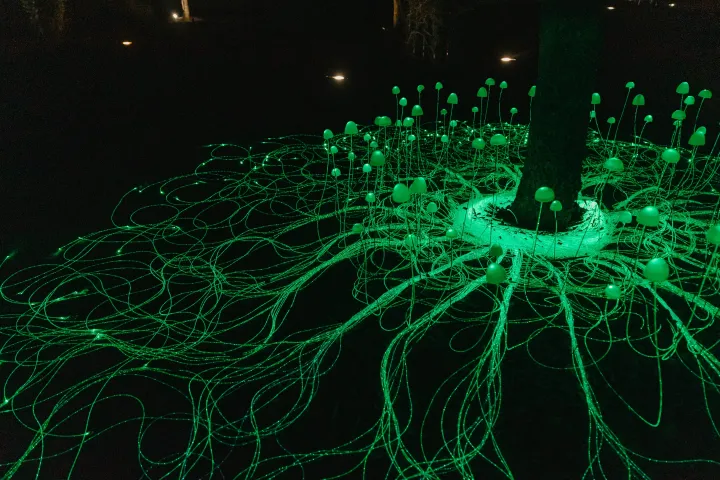
On a farm near Stellenbosch, an annual art festival exhibits installations that have light as an intrinsic component. Visiting doesn’t require a knowledge of art theory – only an imagination and a willingness to engage.
The moon was a silvery sliver, the day was at its end. In the gloaming, a few final shards of sunlight had turned the clouds and the sky into some sort of psychedelic masterwork.
We weren’t meant to be looking up, of course. We were supposed to be chasing a series of artworks that were on the ground, mostly imbued with some sort of artificial light source, something quite different from the stars and moon beckoning overhead.
At Spier, where an annual light art festival is under way until 1 April, artists – most of them conceptual – have created a dizzying diversity of (mostly) abstract pieces meant to inspire you to grapple with some big questions.
Their works don’t so much imitate nature’s ongoing play between light and darkness, as demonstrate new and imaginative ways of using light to make us think – and wonder.
As you wander around the farm trying to figure out what you’re looking at, their works use various forms of illumination to provoke contemplation, awe, astonishment and sometimes just a shrug.
Some of them might not be your cup of tea, but – considering that we humans are programmed to be curious – if you don’t respond in at least some way to what’s on display, the problem might be with you, not the artist.
And that’s half the fun of this exhibition of 21 artworks that you can only properly experience after dark: For each piece, you can come up with your own story, no need to read or listen to an explanation, no need to have your opinion or personal narrative dictated to by a curator or even by hearing what the artist intended.
It’s also an exhibition that will spark playful discussions with the people you see it with.
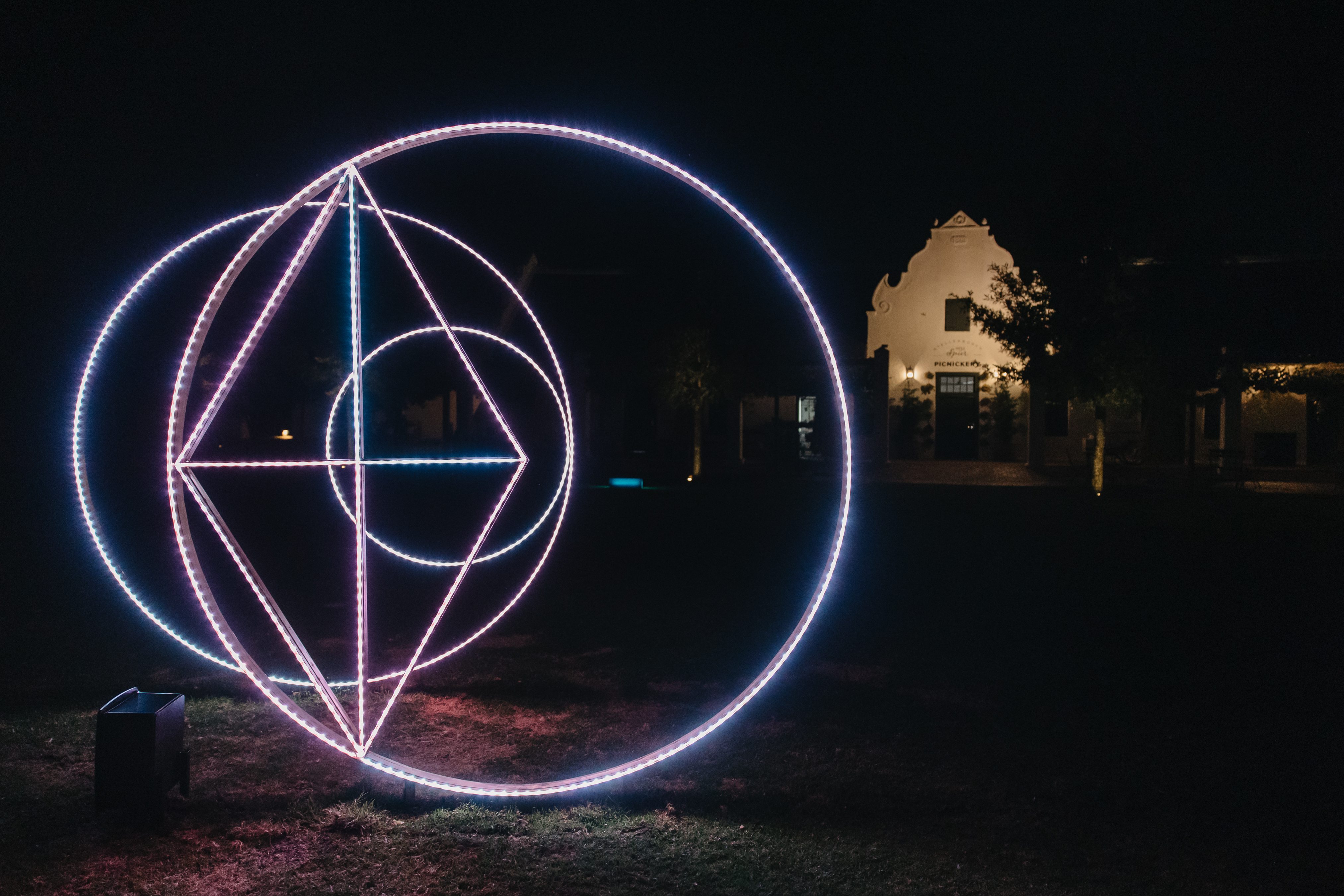
Goldendean’s ‘Vesica Piscis’ concerns non-binary transgender identities (Picture supplied)
We, for example, debated for some time the meaning of the first piece we looked at, by the artist Dean Hutton who goes by “Goldendean”. It’s called Vesica Piscis and resembles a pair of lit-up hula hoops propped up on the lawn where many visitors have their picnics while waiting for the sun to go down before they start exploring.
Even up close Vesica Piscis seemed to constantly be altering its appearance, not only changing colours, but transforming into different sorts of patterns and shapes according to our precise position while inspecting it for clues to its meaning; every angle brought on a different scheme of optical illusions, until I finally became fixated with an idea of what it was and then couldn’t unsee it.
I could not have been more wrong: From the notes on the map, Goldendean’s installation is a provocation to think critically about how transgender identities “challenge the conventional binary understanding of gender”.
My imagination instead saw the outlines of cartoonish fish with bulging eyes swimming in multiple directions.
Meanwhile, my friend wasn’t having any of it. Though she didn’t see any fish, neither of us considered gender politics.
We were off to a wonderfully unintellectual start. And having a blast.
Many of the works are deceptively simple. What we discovered is that such simplicity, rather than prompting us to nod our heads in blind acceptance and move on to the next piece, opened up an inquiry. The human mind wants answers, and sometimes it’s fun to speculate.
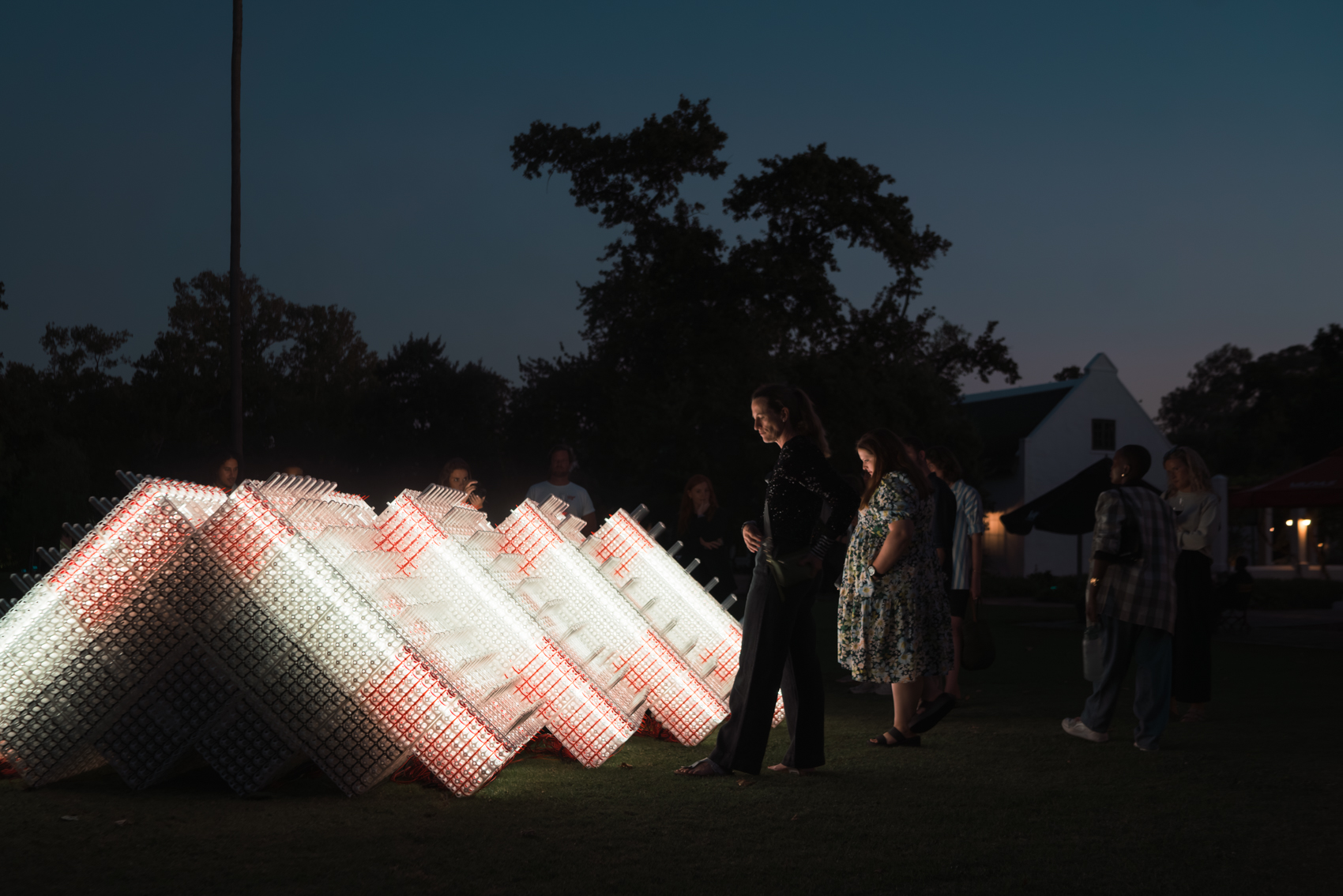
Visitors to the Spier Light Art festival grapple with the meaning of Alan Alborough’s ‘ZZZZ’ (Photo: Supplied)
Artist Alan Alborough’s big, glowing arrangement of carefully stacked plastic containers entitled ZZZZ, for example, had my head spinning with thoughts of worker exploitation, the capitalist-consumer industrial complex, and even wondering if it was perhaps some sort of ecological protest.
Nope.
Diving into the artwork notes, it turns out that it’s about sleep as a metaphor for death or inattention. In other words, the period when we are detached from conscious experience.
The real trick of the work, though, was that it made us want to understand, had us poking about for clues, prodding at various bits and pieces in an attempt to figure out why the artist made what he made.
I’ve always believed that an artist should not have to explain his or her work, that an artwork’s existence must create meaning in the observer’s imagination without excessive explanation.
But making us want to understand it is part of that meaning. It ensured that, hours later, lying in bed, trying to get some real zzzzs, I was still thinking about Alborough’s piece, wondering how he came up with what he created and why he used this medium – plastic and light – to do what he did.
Other works seemed more intellectually accessible.
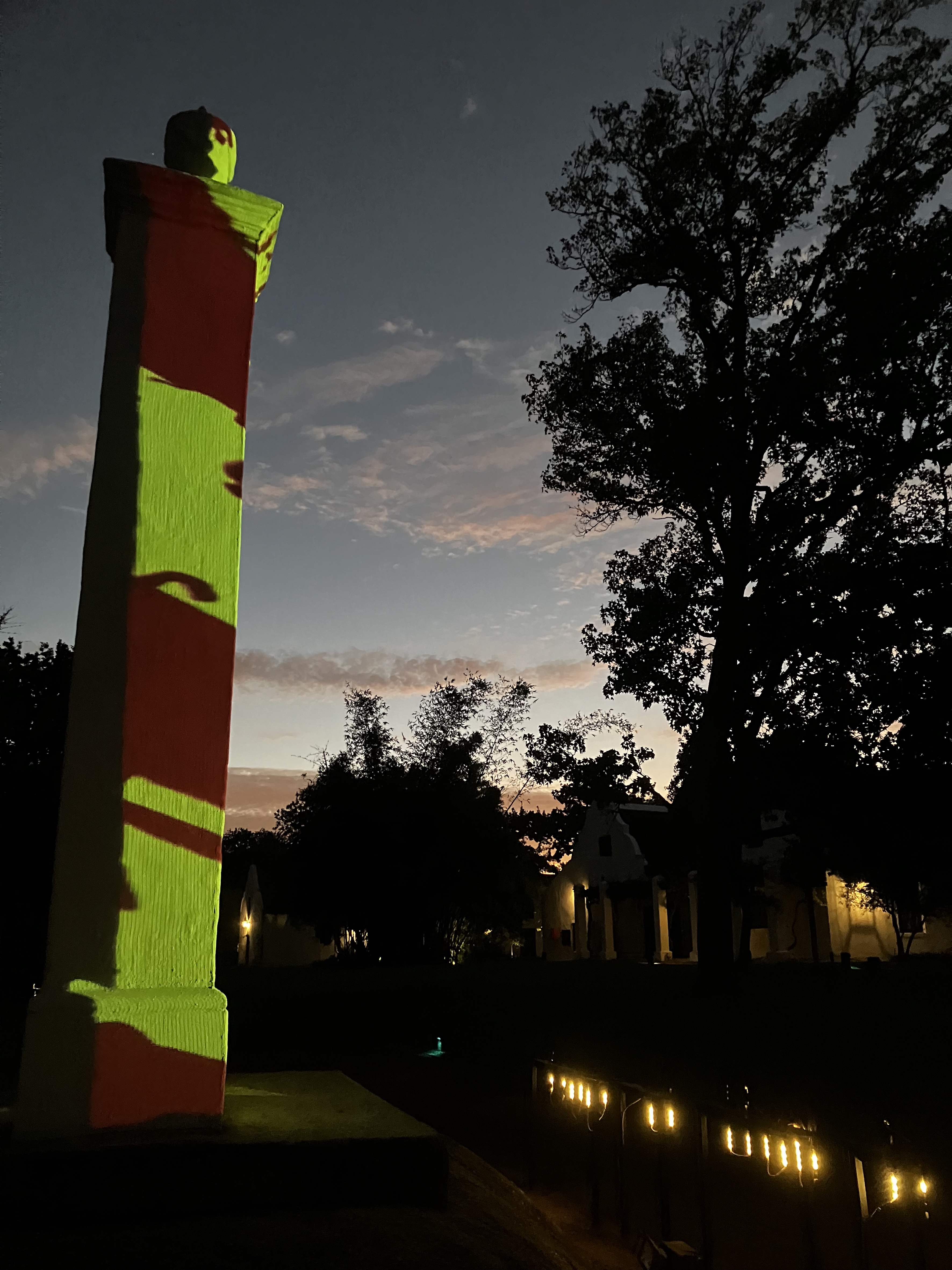
Spier’s old slave bell which has become the canvas for Charles Palm’s disquieting light installation ‘The Boogeyman’. (Photo: Keith Bain)
Charles Palm’s The Boogeyman is a projection onto the white columns of Spier’s old slave bell. While it is immediately unsettling in that it draws attention to the existence of such a structure, recalling one of the great horrors of history, it is also very pretty, captivating in the way that moving, colourful imagery projected onto a white wall in the darkness invariably tends to be – because humans like flashing, moving lights. We like visual distraction.
Dig deeper, though, and the script that forms part of what’s projected onto the slave bell walls turns out to be from a letter written by an enslaved man in 1760.
At the time, the letter – penned in an Indonesian script that white colonists could not decipher – was presumed to be evidence of a planned slave insurrection. To curb the uprising, any slaves associated with the letter were persecuted, tortured and executed.
History, the artwork reminds us, is full of misunderstandings.
The letter, which has recently been properly translated, was in fact the writer, who was sick at the time, asking for medical assistance. Stare at the illuminated slave bell long enough and the connection between now and then feels heartbreakingly intimate.
Some of the works don’t necessarily work only in the way they were imagined.
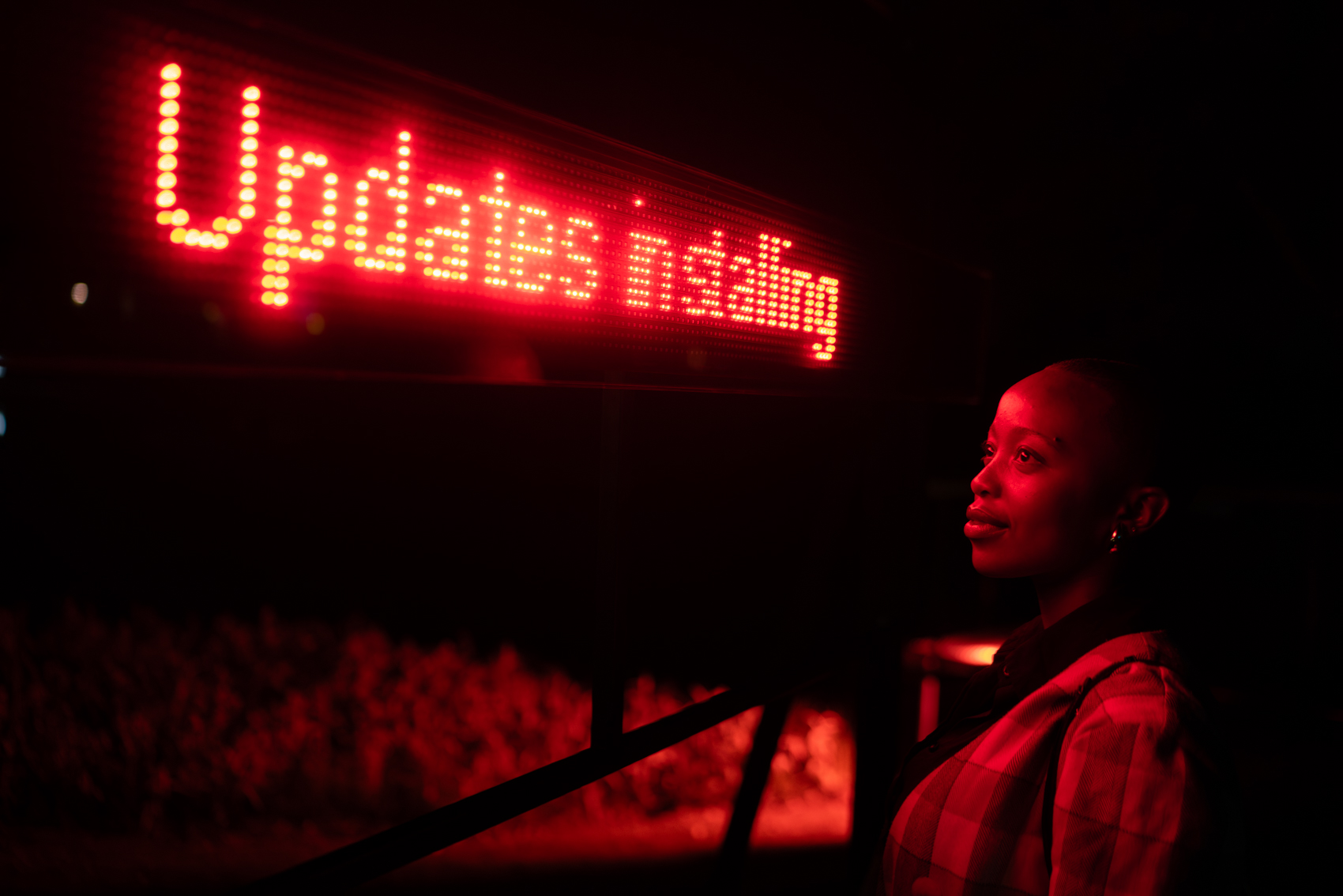
Naadira Patel and Sarah de Villiers’s ‘Assembling Lines’ uses LED screens in a textual allusion to stock market updates at Spier Light Art. (Photo: Supplied)
Marco Chiandetti’s Beacon, for example, looks like a series of miniature greenhouses – futuristic tent-like structures with oak tree saplings inside illuminated by bright mercury vapour bulbs.
While the work is meant to highlight the living conditions of people housed in similar structures in migrant camps, what I got was an eerie impression of what cities might look like if we ever end up colonising Mars.
Probably the most appreciated of the works are those that provoke interactivity.
A hit for us was Jenna Burchell’s Songsmith (The Great Karoo), also known as the Singing Stones, which strangely seemed to have nothing to do with light at all.
Rather, it’s a kind of sound sculpture, a series of small rocks mounted on upright plinths that invite you to place your hands close to the various surfaces, an action which produces, rather mysteriously, all sorts of music. It’s almost like an electronic rock orchestra, but why it’s part of a light-focused exhibition is anybody’s guess.
What an installation like Singing Stones reiterates, though, is the importance of being in the space where the artwork is situated.
It’s not art you merely look at, but something that requires participation. Not only do you participate by being hands on and interacting with the stones in order to make them sing, but you need to physically move between the various stones, altering your proximity to each one in order to get their full effect.
Similarly interactive is Hallie Haller’s Machine Swim, where a screen that looks like it’s nothing but snowlike electronic noise, like a TV screen abuzz with tiny pixels of light, interacts with you.
As you dance – or “swim” – around on one side of the artwork, you witness your shadowy image altering the pattern of fuzz on the opposite screen.
What you experience when you engage with it is that you have become part of the artwork. You have also, in a sense, become a co-creator with the artist.
A different kind of challenge is proposed by Berco Wilsenach’s returning piece, In Die Sterre Geskryf / Written In The Stars, which uses a series of thick glass panels to illuminate similarities between Braille and star charts, both of which use a coding system to convey information.
There is something both hypnotic and exquisitely beautiful in the strange orderliness of the work; you sense its conceptual cleverness even as you realise you can’t quite fathom the extent of its meaning. Many of the people we saw spending time with it also decided it was the best place for photographs and selfies, most of which end up looking weirdly multidimensional.
Then there was Abri de Swardt’s Flood Light, worth seeking out near the far outer perimeter of the vast exhibition area. It looks like something washed up on the banks of the river, perhaps something sinister, a crashed spacecraft, maybe a metallic beast.
It could be many things, of course.
According to De Swardt, it’s a replica of part of a floodlight from the Danie Craven Rugby Fields at Stellenbosch University’s Coetzenburg sports grounds. The imagined backstory is that it became detached from its mast and then, after a flood, turned up at Spier.
Now it’s marooned on a boulder-strewn river bank, strangely alien-looking. Viewed from a low hill on the other side of the river, it’s quite eerie to behold. Lying there, stranded, broken, derelict, forgotten and forlorn, its lights glitching on and off, it’s like the wreckage from some terrible tragedy that has befallen the world.
Stare long enough and it breaks your heart a bit as you realise it’s a reference to the terrible environmental catastrophe we are already facing. The flashing lights hint at our permanent state of distraction, our inability to focus on finding a solution to the unfolding tragedy.
Most beautiful artworks on display?
We were besotted with the one titled Mycelium. Basically we just wanted to hunker down and stare at the ever-changing light display set around the base of a tree like a network of mushrooms.
They weren’t actually magic mushrooms, but they were pretty magical all the same.
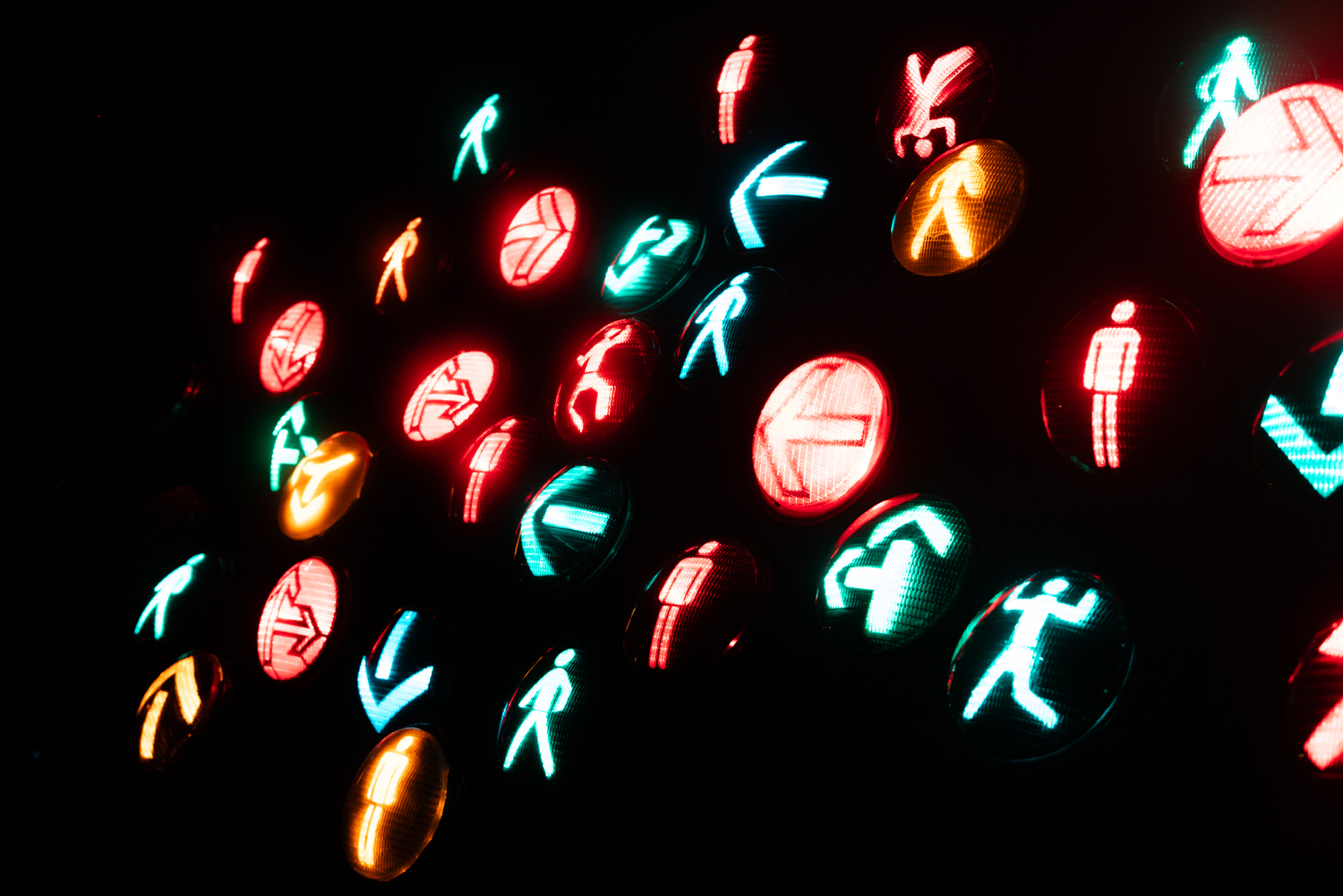
Sophie Guyot’s ‘The Meaning of Meaning’ at Spier Light Art (Photo: Supplied)
And there is also the pretty cleverness of Sophie Guyot’s The Meaning of Meaning, an assemblage of flashing red and green lights used on the streets to send signals to pedestrians and drivers.
Set to music, it’s as though the stick figures and arrows are dancing, caught in a groovy choreographic display that cuts through the darkness in a language that doesn’t require explanation, the simple pictograms communicating in a delightful rhythm rather than by means of intellect.
All of these works and plenty more are on display at Spier until the end of the month and the festival is entirely free.
A spokesperson for the show said last year’s festival drew about 7,000 visitors, a number that’s already on track to be much larger this year. You can arrive and simply explore, or book for a 7.30pm guided tour conducted by drama students from the University of Stellenbosch. Their job is not to tell you how to interpret the works, but to open your imagination to the possibilities of unravelling what you see.
You can also make a night of it by starting with a picnic from Spier’s Picnickery, a burger from the Bubbles & Braai Bar, or dinner at Vadas Smokehouse & Bakery (Friday, Saturday and Sunday only).
On the night we visited, wine also flowed freely and seemed to loosen the imaginations (and tongues) of the many young people who came to explore. That was something wonderful to witness, seeing folks of all ages having fun as they engaged with art that might in a gallery context have proven slightly opaque.
There is something about this gorgeous outdoor setting, with the infinitude of stars overhead and a gurgling river running through it, that permits you to access and experience the work on your own terms.
There’s an informality, the laughter and funny comments, and the people posing for pictures with works of art, all of which makes the whole event feel so human, so democratic, and like an adventure.
At the end of our visit, from the edge of the parking lot, I looked back across the picnic lawn and stared again at Goldendean’s Vesica Piscis for a final opportunity to wrap my head around it.
The installation seemed completely changed, pleasurable in a different way, from when we’d first seen it a couple of hours earlier. It was something new to me, suddenly radically three-dimensional, like a thing beamed in from a distant galaxy. Seeing it so transformed filled me with joy. One day, my brain told me, I might even understand. DM
Spier Light Art 2024 can be visited every evening through 1 April. It is free to view, and a guided tour can be booked in advance. If you set out to explore on your own, be sure to grab a map so you don’t miss anything – a QR code links to detailed explanations of the artworks, if you feel the urge to know more.




















 Become an Insider
Become an Insider
This seems to be a function aimed at the civilised, ones with imagination and SPIRIT, can’t say more could become racist
Spare a thought for the poor sods that have to work 15 hours a day for this type of “festival”.